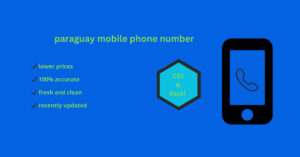The end result for the customer may not reflect the operational complexity behind their seamless shopping experience , but they are certainly two business models with different operating dynamics.
in the infrastructure of an ecommerce , the brand or virtual store has absolute control of its product catalog.
It is the seller who manages the product information , sets up the paraguay mobile phone number website, manages the inventory stock and executes the logistics of sending the orders.

In addition, it is responsible for customer service , ensuring a personalized and consistent shopping experience .
This level of involvement requires significant effort , resources and time, but it also gives ecommerce itself the opportunity to cultivate a direct and closer relationship with its buyers.
Maintaining consistent prices and promoting a strong brand image are part of the strategy to generate customer trust and loyalty .
Purchasing process in a marketplace
the marketplace , on the other hand, presents itself as an intermediary that makes it possible for multiple sellers to offer their products to a wide audience .
Here, buyers benefit from being able to compare a wider range of options and make transactions from the comfort of home.
In this model, sellers manage their own inventory and shipping and return policies, but the platform provides the basic infrastructure for transactions.
The responsibility for detailed logistics and operational management can be partially or fully outsourced, thanks to additional services provided by the marketplace, such as advertising and logistics support .
This gives sellers more room to focus on expanding their product catalog and reaching more potential customers without worrying about technical issues or platform quirks.
